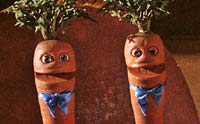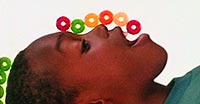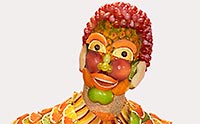Nightmares Made Real
My first special effects job for a feature film happened in 1986 at Image Engineering, a mechanical effects company owned by Peter Chesney. The movie was A Nightmare on Elm Street 3: Dream Warriors, and Image Engineering was responsible for many of the creative ways that the maniacal Freddy Krueger disposed of his victims in the dream world. Unlike the computer-generated visual effects of today, which are completed in post-production, this was a pre-production project that required a performance with the actors during the live action shooting. Let's take a look at how we seemingly made a bathroom sink and a television come to life as the personification of evil Freddy.

While most of the crew focused on the inner mechanisms, my task was to make the visible exterior of the transforming props. I worked under the guidance of Anton Tremblay, who designed the look of the specialty props for this project. The transforming faucet knobs were scratch-built, which I sculpted using Bondo, styrene plastic, and wood based on Anton's drawings. Molds were made from the original master, and then many castings were produced for use in the various transformation stages. The casting materials depended on the function of each prop: rock-hard fast-cast, stretchy Smooth-On rubber, flexible urethane rubber, or breakable stearin wax. One knob turned into a grasping hand, while the other morphed into the iconic Krueger claw. Later on, during the film's principal photography, I also puppeteered the transforming faucet knobs. Essentially, I was hidden away under the sink, struggling to perform while using a video monitor to see what I was doing and interacting with Patricia Arquette!



Anton's design for the Krueger television was also fabricated from scratch. There needed to be a functioning TV, several transforming versions that housed all the mechanics, as well as one that would fit actor Robert Englund. I don't know much about how the mechanics were built as that is not my expertise, but the work of the mechanical department was amazing! I modeled the components on the face of the TV separately: speaker grills, screen bezel, knobs, and decorative details. Multiple castings of the parts were made and applied to each television, all of them carefully painted to look the same. Image Engineering did not have a ventilated spray booth, so the casting and painting process was conducted in the alley outside because the vapors were toxic. Despite this, I was still exposed to a fair amount of noxious fumes on this job! The mechanical arms were dressed with real electronic components, including tubes that were wired to glow. As fans of the "Elm Street" series know, Freddy Krueger became a wise-cracking comedian in this movie. The television sequence became iconic due to Freddy's famous line, "This is it Jennifer. Your big break in TV. Welcome to prime time, bitch!"




The collaborative efforts of the Image Engineering team resulted in some truly impressive special effects. I'm proud of the work we did, even though it was for a gruesome horror movie. I love sculpting and model-making, bringing something into existence from raw materials. I learned a tremendous amount about the fabrication process on this job; however, I urge caution to anyone considering this sort of art form as a profession. The materials, glues, paints, and exotic chemicals that are routinely used by model makers can be hazardous to your health and even deadly in the long run! Fortunately, most of my work in the film industry has been in animation. If I had continued to do a lot of prop and model-making jobs, maybe I would be an unintentional victim of Freddy Krueger by now!
Nightmare on Elm Street 3: Dream Warriors © 1987 New Line Cinema







































